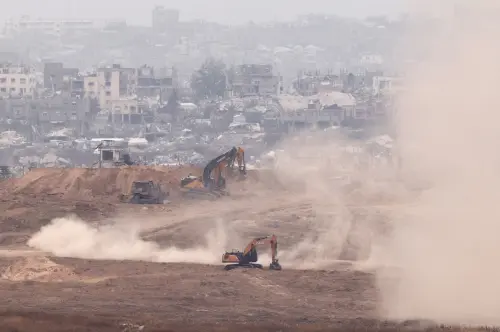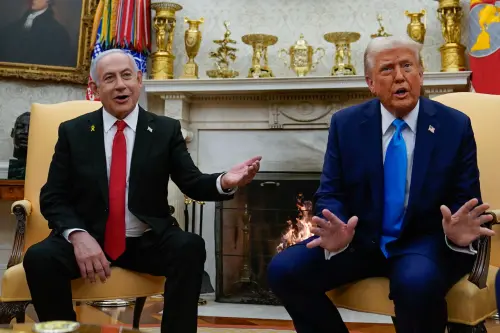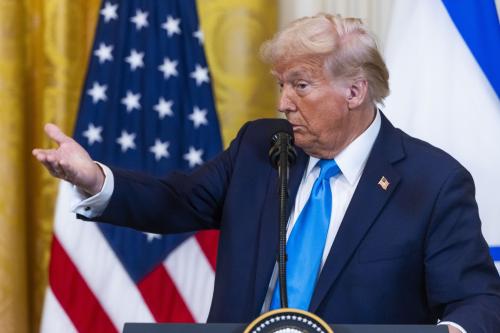The following draws on new joint research by experts at Brookings and the Center for a New American Security (CNAS). Read the full report—“Ending Gaza’s perpetual crisis: A new U.S. approach”—and attend or watch the related event.
Crisis remains the baseline in Gaza, and wider conflict always looms near. Recent weeks reinforced this reality, as Israel and Hamas teetered on the edge of catastrophe after an Israeli covert incursion into Gaza was exposed, nearly leading to another war that nobody wanted.
None of this is new. A bloody cycle has been repeating itself for over a decade. Hamas uses demonstrations and violence to pressure Israel, and Israel uses an economic blockade, tacitly supported by Egypt, as well as military actions to pressure and contain Hamas. Eventually an incident of some sort leads to a significant explosion—just as we saw in recent weeks.
Then, after a certain amount of violence, Egypt and the U.N. typically mediate a deal to end the fighting. This sometimes comes after the sides have suffered just a handful of casualties, but sometimes after many more—as was the case in 2014 when war led to over 2,100 Palestinian and over 70 Israeli deaths. Through this mediation, Israel agrees to some marginal economic relief for Gaza in exchange for an unstable short-term ceasefire. The parties never move beyond this toward a more sustainable political deal, and the tragic cycle repeats itself, again and again.
The United States, which has spent most of its energy on that elusive “deal of the century” between Israelis and Palestinians, is ill-prepared for these rounds of conflict and therefore quietly supports short-term quiet-for-quiet deals. It wants an immediate solution that addresses the humanitarian situation, but fears that such a deal will reward Hamas for bad behavior and give it the economic benefits it needs to permanently consolidate power in Gaza, separating it from the West Bank and harming the prospects of a two-state solution.
The biggest losers in all of this are the nearly two million people of Gaza, which is just twice the size of Washington, D.C. They live in terrible conditions, with an economy that has nearly ground to halt. As only a few hundred Palestinians, on average, are able to exit Gaza every day, unemployment has risen to one of the highest rates on earth—over 50 percent. Severe shortages of electricity and clean drinking water also plague Gaza—97 percent of the water in its aquifer is unfit for human consumption. Meanwhile, the people of southern Israel are routinely subject to rocket fire and the burning of their fields by incendiary kites.
Ironically, the latest fighting comes soon after an apparent breakthrough. In early November, with Israeli consent, suitcases full of Qatari cash entered the Gaza Strip and reached Hamas—a move that was intended to be an early step towards reducing tensions. Israel and Hamas, when not killing each other, appear ready to reach some sort of accommodation, and to accept some political risk to do so.
Neither Israel nor Hamas wants to keep fighting, but they have not found a way out.
Herein lies another tragedy of the Gaza Strip. Neither Israel nor Hamas wants to keep fighting, but they have not found a way out on which they can agree. And so they perpetuate the status quo while civilians on all sides suffer.
The Hamas leadership wants an end to the blockade but wants to stay in power. It is willing to enter a long-term ceasefire and even to give up some of its responsibility for governance in Gaza to the Palestinian Authority (PA), but insists on keeping its weapons.
Israeli leadership wants an end to the fighting but fears that relieving the blockade will further legitimize Hamas and allow it to rearm or build attack tunnels. As it heads into an election year, Israel’s freedom of maneuver is also highly constrained by domestic politics. Netanyahu’s wise but unpopular decision in November to avoid a broader war led to wide criticism from both the right and the left and resulted in the resignation of Defense Minister Avigdor Lieberman.
The Palestinian Authority leadership, which governs in the West Bank and has renounced violence against Israel, fears that any deal between Israel and Hamas will permanently separate Gaza from the West Bank and legitimize Hamas. But it wants no part of ruling Gaza unless Hamas gives up its weapons and has objected to any international deals that would strengthen Hamas like the one recently approved by Israel.
The situation is further complicated by the wide array of external diplomatic players, including Egypt, the European Union, Qatar, Turkey, the United Arab Emirates, and the United States. These actors have somewhat conflicting interests in Gaza and none has the leverage to singlehandedly force a solution. Instead, by working at cross-purposes, they tend to make things worse.
Here’s what might work: The United States and Egypt, with the Office of the U.N. Special Coordinator for the Middle East Peace Process, should agree—as key influencers to the parties—on a joint framework, get the rest of the international community on board, and push it in times of both conflict and peace. Such a framework would join short- and long-term economic stabilization initiatives with the political arrangements needed to avert conflict and achieve the reintegration of Gaza and the West Bank.
As a first step, the plan should include immediate steps to alleviate the humanitarian crisis, among them measures to drastically improving the supply of water and electricity. But more important will be allowing greater freedom of movement for Palestinian people and goods in and out of Gaza, including the issuing of some number of permits for residents of Gaza to work in Israel, where many thousands once worked in the 1990s. Indeed, it is this freedom of movement that lies at the core of the economic crisis in Gaza, which cannot be alleviated unless Gaza is opened to the world.
The plan must also include a sustainable political deal that includes all three main parties: Israel, the Palestinian Authority, and Hamas. As part of this, Hamas must commit to a long-term ceasefire and gradual, though probably imperfect, demilitarization. Israel must agree to significantly ease the blockade on Gaza as part of the ceasefire. And the Palestinian Authority must agree to slowly resume control over elements of governance in Gaza, even while Hamas retains some weapons. Further, Hamas would receive a role in future Palestinian decisionmaking, but only through accepting the supremacy of the Palestine Liberation Organization (PLO). And, finally, Israel would need to take significant positive steps in the West Bank to strengthen the footprint of the PA’s control to signal that this deal is wider than just Gaza, incentivizing the PA’s participation and providing the foundation for a long-term solution for the Israeli-Palestinian conflict.
We recognize that the arrangement we propose contains a number of component parts that have proven difficult to achieve in themselves. Yet their realization becomes more likely—although still far from easy—in combination, with benefits for each actor balancing the concessions required of them, and with the weight of the coordinated international actors behind them. Still, our proposal faces many obstacles and at present would likely not have buy-in from all the relevant parties. Its achievement may only be possible with the extreme pressures the parties would face in the middle of another war or with changes of leadership or policy from Israel, the Palestinians, and the United States.
Nonetheless, short of comprehensive peace, this framework is the most viable option we see to ending the perpetual crisis in Gaza, which itself is a key component to broader Israeli-Palestinian peace. Therefore, the international community can and should start working together now to set the table for this solution, even if it is still years away. Israelis and Palestinians deserve better than this perpetual cycle of violence and economic malaise.
The Brookings Institution is committed to quality, independence, and impact.
We are supported by a diverse array of funders. In line with our values and policies, each Brookings publication represents the sole views of its author(s).









Commentary
How to fix Gaza
December 3, 2018